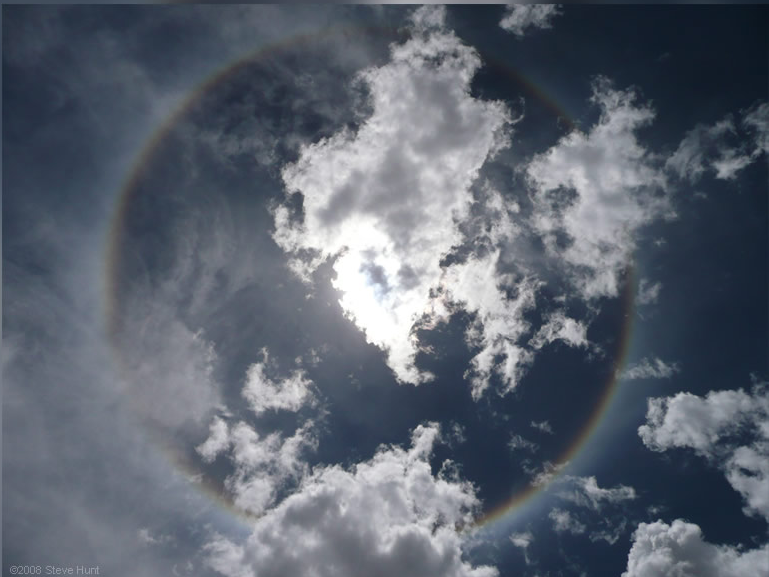Hole in the sky ~ Bolivia
Hole in the Sky: Exploring Atmospheric Optics in Bolivia
Atmospheric optics is a fascinating field that unveils the mesmerizing phenomena occurring in our skies. One such captivating sight is the "hole in the sky" observed in Bolivia, where a peculiar halo appears, leaving a dark void in its wake. This phenomenon, known as the High Sun Ice-Halo, offers a unique spectacle that has captured the attention of sky enthusiasts and scientists alike.
The High Sun Ice-Halo observed in Bolivia is a type of halo known as a 22° halo or circumscribed halo. These halos are visible worldwide, regardless of the ground level temperature, due to the presence of cold cirrus clouds. While it may be challenging to distinguish between the different types of halos at high sun, the 22° halo stands out with its distinctive characteristics.
When a 22° halo forms, it creates a dark "hole in the sky" effect. This occurs because hexagonal ice crystals closer than approximately 22° to the sun cannot refract light towards the observer's eye. As a result, the halo rays pass between faces inclined at an angle of 60° to each other and are deviated by a minimum of around 22°. However, some rays may be deviated as far out as 50° from the sun. Interestingly, the halo displays a red edge due to the fact that red rays are deviated the least.
To understand the formation of this mesmerizing halo, we must delve into the intricate nature of ice crystals. These crystals can assume various rotational positions, with the deviation being minimal when the internal ray is parallel to a face and the ray path plane is perpendicular to the crystal's long axis. This unique alignment and interaction of light with the ice crystals give rise to the captivating High Sun Ice-Halo.
The High Sun Ice-Halo observed in Bolivia serves as a reminder of the awe-inspiring phenomena occurring in our atmosphere. It is a testament to the intricate interplay between light and ice crystals, resulting in a visual spectacle that leaves viewers in wonder. By studying and analyzing these atmospheric optics phenomena, scientists gain insights into the composition and behavior of ice crystals, which can contribute to a deeper understanding of our planet's climate and weather patterns.
To fully appreciate the beauty and complexity of atmospheric optics, it is crucial to explore these phenomena from various geographical locations. While the High Sun Ice-Halo has been observed in Bolivia, similar halos can be witnessed in different parts of the world. Each location offers its unique atmospheric conditions, influencing the formation and appearance of these captivating optical phenomena.
In conclusion, the High Sun Ice-Halo observed in Bolivia provides a captivating glimpse into the world of atmospheric optics. This phenomenon, with its distinct "hole in the sky" effect, showcases the intricate interplay between light and ice crystals. By unraveling the mysteries of these atmospheric phenomena, scientists continue to deepen their understanding of our planet's atmosphere and gain valuable insights into the complex dynamics shaping our world. Whether observed in Bolivia or elsewhere, these optical wonders never fail to leave us in awe of the beauty and complexity of our natural world.

High Sun Ice-Halo imaged in Bolivia, October '08 by Steve Hunt.
Image ©Steve Hunt, shown with permission.
Halos are visible world-wide regardless of the ground level temperature because cirrus clouds are always cold. This is a 22° halo or circumscribed halo. The two are hard to tell apart at high sun.
Both halos leave a dark 'hole in the sky' because hexagonal crystals closer than ~22° to the sun cannot refract light towards the eye. The halo rays pass between faces inclined 60° to each other and are deviated by a minimum of ~22°. However, some rays are deviated as far out as 50° from the sun. The halo has a red edge because red rays are deviated least.

Crystals can take all rotational positions. The deviation is least when the internal ray is parallel to a face and the ray path plane is perpendicular to the crystal long axis.
Note: this article has been automatically converted from the old site and may not appear as intended. You can find the original article here.
Reference Atmospheric Optics
If you use any of the definitions, information, or data presented on Atmospheric Optics, please copy the link or reference below to properly credit us as the reference source. Thank you!
-
<a href="https://atoptics.co.uk/blog/hole-in-the-sky-bolivia/">Hole in the sky ~ Bolivia</a>
-
"Hole in the sky ~ Bolivia". Atmospheric Optics. Accessed on November 26, 2024. https://atoptics.co.uk/blog/hole-in-the-sky-bolivia/.
-
"Hole in the sky ~ Bolivia". Atmospheric Optics, https://atoptics.co.uk/blog/hole-in-the-sky-bolivia/. Accessed 26 November, 2024
-
Hole in the sky ~ Bolivia. Atmospheric Optics. Retrieved from https://atoptics.co.uk/blog/hole-in-the-sky-bolivia/.